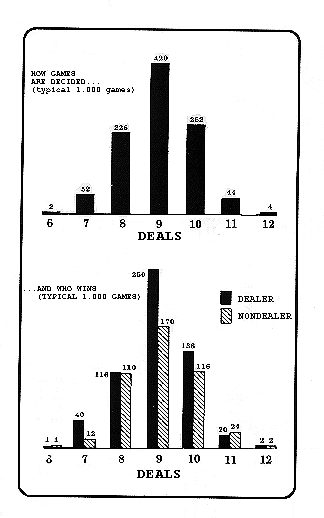Tip 1: "Sleeper" cards
Tip 2: The magic eleven
Tip 3: The non-dealer 5-card trap
Tip 4: The dealer 5-card trap
Tip 5: Trapping the J
Tip 6: Other traps
Tip 7: Logic!
Tip 8: The end game: defensive pegging
Tip 9: The end game: offensive pegging
Tip 10: Twenty-Six Theory, part 1
Tip 11: Twenty-Six Theory, part 2
Tip 12: Twenty-Six Theory, part 3
Tip 13: Twenty-Six Theory, part 4
Tip 14: Twenty-Six Theory, part 5
Tip 15: The first dealer's par holes
Tip 16: The first non-dealer's par holes
Tip 17: Average game length
Tip 18: Non-dealer hand analysis
Tip 19: Dealer hand analysis
Tip 20: Dealer and non-dealer scoring odds

Many games of cribbage are won or lost by simply knowing the odds and playing the hand accordingly. Study this chart and those in the following tips, and you will improve your knowledge of cribbage probabilities. These probability tidbits are especially helpful when playing those last critical hands, and that crucial endgame pegging that decides so many games.
Remember, hunch players are losers. Play the odds, and sooner or later you will be rewarded with the majority of victories.
The charts are based on samples of 1,000 or more. Your own games should parallel these findings. Of course, millions of games would have to be analyzed to pinpoint these probabilities precisely. And this is what makes cribbage such an exciting game, the endless combinations of cards and pegging possibilities.
The chart analyzes the number of deals in a typical cribbage game, and who has the advantage (the dealer or the non-dealer). The chart shows that a nine-deal game is by far the most common (about 42% of all games are played in nine deals). The lower chart shows that the dealer wins about 19% more than the non-dealer (250-170) in a nine-deal game. It also shows that about 90% of all games are played in eight, nine or ten deals. In an average game, the non-dealer comes up about five points short, and the dealer wins, usually by counting his/her crib to win the game. By using the Twenty-six Theory as your guide, you can cut the dealer's ninth deal advantage.
- Republished from Play Winning Cribbage by permission. Text copyright © 2002 by DeLynn Colvert. All rights reserved.
Previous | Next